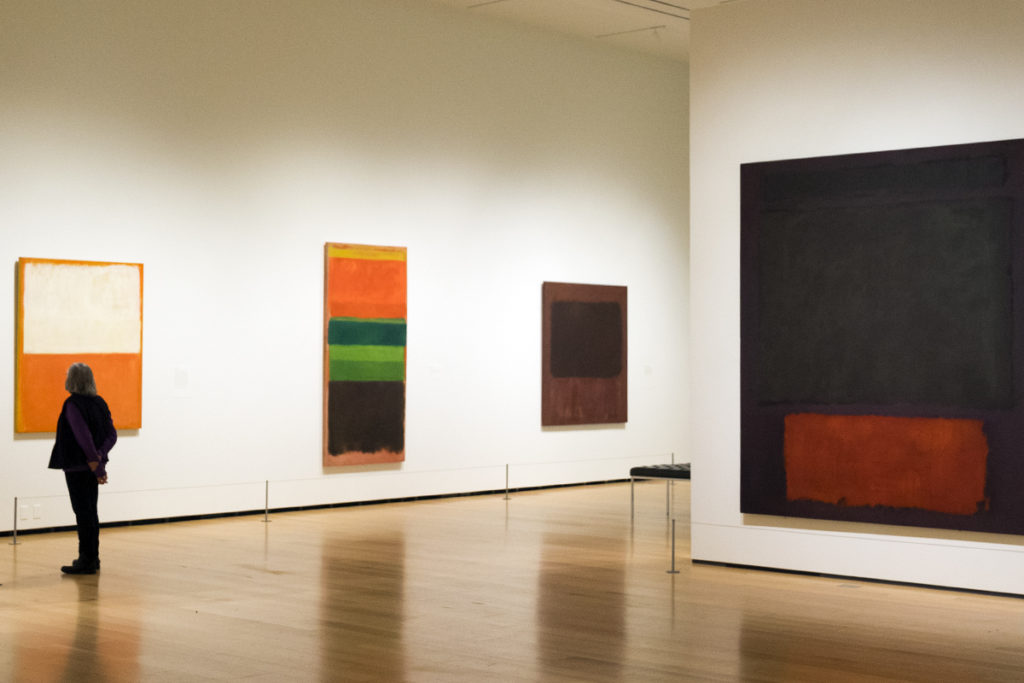Large-scale compositions comprised of horizontal bands of color protrude from the gallery wall. Nuanced, bold, and evocative. Mark Rothko believed that the painting, not the artist, should dictate the viewer’s emotional response.
Mark Rothko: Reflection marks the first focused display of Rothko’s paintings at the Museum of Fine Arts Boston. The museum previously showed a Rothko from Christopher Rothko’s private collection when the Art of the Americas Wing opened in 2010.
With an illustrious career that spanned five decades, Rothko created some of the most iconic masterpieces of the 20th century. Abstract expressionism characterizes his work despite his distaste for labeling art.
The exhibit features 11 major works spanning his career. The exhibition is divided roughly into thirds: The first four paintings depicting his early breakthrough phase of the “multiforms”, another four from the so-called “classics” of the ’40s to early ’60s, and finishing off with his later works, “the black paintings.”

Elliot Bostwick Davis curated the exhibit in connection with the Seeking Stillness show. While visiting the National Gallery of Art in Washington D.C., last November, Davis met with Harry Cooper, the museum’s head of modern art. Cooper generously offered to loan 11 Rothko paintings from the National Gallery—the repository for the Rothko bequest—to the MFA.
Davis discussed how Rothko’s paintings resonate with many people, saying that he took on the big existential questions of human emotion in his art. She adds that many people are moved to tears in front of his paintings.
“I felt the powerful experience of his work for the first time as an undergraduate when I went to the Phillips Collection in Washington D.C.,” Davis said. “I sat in the Rothko Room and found it really overwhelming.”
The exhibit doesn’t start the way you would expect it to. The first piece is not a Rothko, but instead Rembrandt’s Artist in his Studio, the source of inspiration for Rothko’s self-portrait Thru the Window. The two paintings are presented side by side, reinforcing the notion that Rothko often turned to the Old Masters for inspiration. The small painting is on public view for the first time in the United States, and also served as the starting point for curating the exhibit.
“The picture I couldn’t get out of my mind was Thru the Window because I didn’t know of it and found it fascinating,” Davis said. “ For me that became the way to see the rest of the works we selected.”

Rothko’s other early works on display include Untitled (1945), the product of his experimental phase working with formal elements like color, shape, and depth. The exhibition then moves into the “multiforms” of the late 1940’s. No. 9 and No. 10 are some of Rothko’s most vibrant paintings featuring suspended colored forms with blurred outlines of which he would become renowned for.
The exhibit then transitions into Rothko’s “classics”, where his signature style of painting large rectangles of color appear to float off the canvas. Four paintings from this era are included in the exhibit, showcasing the progression of Rothko’s trademark technique.
Rectangular planes of yellow, red, green, and dark purple make up the composition of Untitled (1949), one of Rothko’s famous transitional works. Untitled (1955) shows Rothko refine his technique of using thin washes of paint to create a sense of depth and luminosity of color.
A narrow wall divides the exhibit into two spaces, with No. 1 on the backside. The painting was created at a time when Rothko began to use a darker palette for his paintings. Eyes are instantly drawn to the bottom of the canvas where an incandescent red rectangle seems to hover over the maroon background. The austerity in this work carries over to the last “classic” Mulberry and Brown, a somber image painted using hide glue and egg—a method used during the Italian Renaissance.
The exhibit closes with three of Rothko’s grim “black paintings.” He created 14 of these works later in his life while he was physically ill and suffering from depression. On the surface, these vast canvases appear to be solid black, but shapes begin to emerge with sustained viewing.

Rothko’s abstract formula in No. 7 is altered to a single dark square that almost completely fills the canvas and sits above an even darker background. Adjacent to this is No. 8, which appears to have the exact dimensions of its counterpart. If you look closely at the painting, you can see a disparity of tone and hue across the black surface of the canvas.
On the other side on the wall where No. 1 sits, is No. 6 which is barely distinguishable from the other two black paintings parallel to it. Rothko committed suicide in 1970, making the “black paintings” his last pieces of work.
Davis insisted the Rothko’s paintings are best viewed through slow looking. The exhibit encourages you to view each canvas for one full minute, and see how the work evokes emotion.
“We were hoping that it would offer the public a chance to try this method of slow looking and really reflecting on what you are seeing,” Davis said.
Featured Image by Julia Hopkins / Heights Editor





You must be logged in to post a comment.